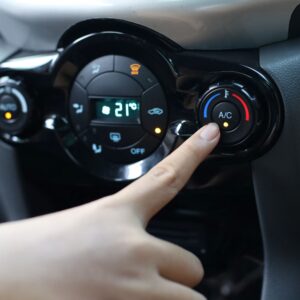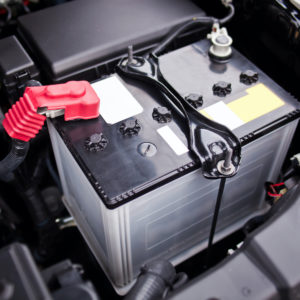Turning on your vehicle’s air conditioner (A/C) is simple, right? Just turn the knob or press a button and you’re good to go. But if you want to cool your hot cabin right away, here are a few things you can try.
Ventilate the Cabin
If your vehicle’s been out in the sun or sitting in a hot parking lot, the air inside the cabin is probably very warm and uncomfortable. Getting the warm air out is quicker than cooling it with your A/C fan. Try opening the windows and doors before getting in your vehicle. That’ll help ventilate the cabin. Turn on your A/C fan to speed up the process. You’ll probably want most of the hot air out before opening the A/C.
If you’re in a rush, you can also roll down your windows while driving, with the A/C on full blast. This gets the old air out faster. It might feel like you’re wasting the cool air coming from your A/C, but it’s sure to cool down the cabin in record time. Leave the windows open for 10 to 20 seconds before rolling them back up and enjoying the cool cabin air. The A/C takes around that long to start cooling anyway, so you’re actually speeding up the cabin-cooling process.
Avoid Precooling
You might be tempted to sit and wait for the A/C to cool your vehicle’s cabin while parked, but this is surprisingly inefficient. Your A/C condenser runs best when it runs in tandem with your engine. So start driving right away if you want your cabin to cool faster.
That said, you can try precooling if your vehicle has a remote start. You can turn the A/C on remotely in many modern vehicles, which is a great time-saver. It won’t be the most efficient way to cool your cabin quickly, but it’s certainly much more convenient to enter an already cold car if you’re in a rush. Just remember not to keep your vehicle idling for more than 30 minutes.
Set Temperature to the Lowest Setting
Your vehicle’s A/C automatically cools air to 38 degrees. This is the coldest setting on most vehicle thermostats. If you set your A/C to higher temperatures, the A/C reheats the air it cooled, which takes up more fuel and effort on the A/C’s part. If you’re looking to cool your vehicle quickly and efficiently, setting your A/C to the lowest temperature setting is the key.
Also, if you have a climate control system in your vehicle, the system adjusts the fans and the A/C automatically. The vehicle will only do this if you have the auto function on. Otherwise, it’ll use the settings you select.

Adjust Recirculation Mode
Recirculation mode pulls air from the cabin and circulates it, reusing the air in the cabin to cool the cabin. This is great for hot weather because with recirculation mode off, the A/C would need to pull warm air from outside and work harder to cool it. It’s also not drawing in air from outside, so you can avoid smells that contaminate the outside air.
However, recirculation has its drawbacks. It pulls air from the front of the cabin, which means the air in the back of the cabin can become warm and stagnant. If you’re driving on your own or with a passenger in the front seat, it’s fine to leave recirculation mode on. If you have passengers in the back though, it’s best to leave it off.
Avoid Using Stop/Start
Newer vehicles have automatic start/stop systems that turn off your vehicle’s engine when they sense that your car’s come to a halt. The system helps improve fuel economy and reduce emissions, but it also interferes with your vehicle’s A/C efficiency. The start/stop system typically shuts down the A/C compressor when it shuts down the engine. If the compressor is off for too long and it’s a particularly hot day, the A/C won’t be able to keep your cabin well-cooled. It’s best to avoid using start/stop if you’re looking at long lines of traffic on a hot summer day, or you’ll find yourself uncomfortably warm.
Maintain the Air Filter
If your cabin’s air filter is all clogged up, it prevents good airflow, which of course affects how well your A/C cools your cabin. If the cabin air filter gets really dirty, you’ll end up only breathing in recirculated air through that filter. If you have allergies this can cause a lot of issues. You can usually find the filter behind the glove compartment in newer cars, and it’s fairly accessible and easy to check and change.
Another thing about the cabin filter is if it gets really dirty, you’ll be breathing in recirculated air through that filter. This will cause issues if you have allergies.
–Anthony Harlin, ASE Certified Master Automobile Technician
FAQs
How Does the A/C Affect Battery Drain and Gas Consumption?
Some people think that using their vehicle’s A/C will drain their vehicle’s battery or increase its gas consumption. You’ll be pleased to know that EVs don’t run out of power much faster if you use the A/C. The difference is negligible. The reason that fuel economy goes down is because when the A/C is on, the cooling fan or fans stay on almost all the time. The strain on the engine and the A/C compressor turning on and off also contribute to reduced fuel economy.
As for gas vehicles, the results depend on the situation. Using your vehicle’s A/C can increase fuel consumption by 8 to 10 percent, but the alternative is sitting in a hot, uncomfortable cabin. While keeping your windows open might seem like the more eco-friendly option, it can actually use up more gas because of the resulting drag. If you’re speeding down a hot highway at 55 mph or faster, keep the windows closed and your A/C on. If you’re cruising at lower speeds and can handle the outside temperature, then you can keep the windows open to save fuel.
How Often Should I Clean My A/C?
It’s best to clean and maintain your vehicle’s A/C system every three years. If you’ve followed all the advice in this article and your A/C still isn’t cooling your cabin well, it might be time for a maintenance check.
There isn’t a hard and fast rule on how to properly turn the A/C on in a car, but these tips should certainly help you do so more efficiently. The next time you sit down in a hot cabin, try a few of them. Then relax and enjoy the chill.
Get Replacement A/C System Parts Without Leaving Your Home
If your A/C isn’t cooling down your cabin no matter what you do, there’s probably something wrong with one of your vehicle’s A/C system components. You don’t want to sit in an uncomfortably warm cabin while driving, so it’s best to replace the faulty part as soon as possible. Thankfully, getting replacement parts is easy at CarParts.com.
CarParts.com offers a convenient solution for anyone looking to order quality replacement parts from the comforts of home. We’ve made our website easy to navigate, with a bunch of filters that allow you to sort our extensive catalog by your preferred brand, price range, and more. You can even use our built-in vehicle selector to view parts guaranteed to fit your vehicle. It only takes a few quick clicks to add your replacement parts to your cart and check out.
Get your A/C back up and running so you can enjoy a comfortably cool cabin even on hot days. Buy a replacement A/C compressor and other A/C system parts at CarParts.com now.
Any information provided on this Website is for informational purposes only and is not intended to replace consultation with a professional mechanic. The accuracy and timeliness of the information may change from the time of publication.


















